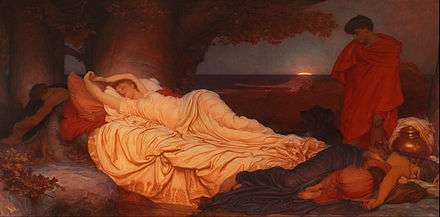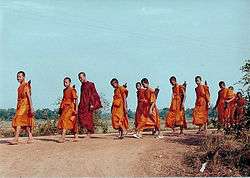Saffron (color)
| Saffron | |
|---|---|
| Hex triplet | #F4C430 |
| sRGBB (r, g, b) | (244, 196, 48) |
| CMYKH (c, m, y, k) | (4, 23, 81, 5) |
| HSV (h, s, v) | (45°, 80%, 96%) |
| Source | Maerz and Paul[1] |
|
B: Normalized to [0–255] (byte) H: Normalized to [0–100] (hundred) | |
Saffron is a color that is a tone of golden yellow resembling the color of the tip of the saffron crocus thread, from which the spice saffron is derived.
The first recorded use of saffron as a color name in English was in 1200.[2]

Variations of saffron
Rajah
| Rajah | |
|---|---|
| Hex triplet | #FBAB60 |
| sRGBB (r, g, b) | (251, 174, 96) |
| CMYKH (c, m, y, k) | (0, 32, 62, 2) |
| HSV (h, s, v) | (29°, 62%, 98%) |
| Source | [3][4] |
|
B: Normalized to [0–255] (byte) H: Normalized to [0–100] (hundred) | |
Displayed at right is the color rajah.
"Rajah" is a bright deep tone of saffron.
India saffron or deep saffron
| Deep saffron | |
|---|---|
| Hex triplet | #FF9933 |
| sRGBB (r, g, b) | (255, 153, 51) |
| CMYKH (c, m, y, k) | (0, 50, 90, 0) |
| HSV (h, s, v) | (34°, 80%, 87%) |
| Source | Vexillological: |
|
B: Normalized to [0–255] (byte) H: Normalized to [0–100] (hundred) | |
 | |
| Name | India |
|---|---|
| Use |
National flag |
| Proportion | 2:3 |
| Adopted | 22 July 1947 |
| Design | Horizontal tricolour flag (India saffron, white, and India green). In the center of the white is a navy blue wheel with 24 spokes |
| Designed by | Pingali Venkayya[N 1] |
The National flag of India is officially described in the Flag Code of India as follows: "The colour of the top panel shall be India saffron (Kesari) and that of the bottom panel shall be India green. The middle panel shall be white, bearing at its centre the design of Ashoka Chakra in navy blue colour with 24 equally spaced spokes."[5] Deep saffron approximates the color of India saffron.[6][7] India saffron, white and what is now called India green were chosen for the three bands, representing courage and sacrifice, peace and truth, and faith and chivalry respectively.[8]
Sarvepalli Radhakrishnan, who later became India's first Vice President and second President, described the significance of the Indian National Flag as follows:
| “ | Bhagwa or the saffron colour denotes renunciation or disinterestedness. Our leaders must be indifferent to material gains and dedicate themselves to their work. The white in the centre is light, the path of truth to guide our conduct. The green shows our relation to (the) soil, our relation to the plant life here, on which all other life depends. The "Ashoka Chakra" in the centre of the white is the wheel of the law of dharma. Truth or satya, dharma or virtue ought to be the controlling principle of those who work under this flag. Again, the wheel denotes motion. There is death in stagnation. There is life in movement. India should no more resist change, it must move and go forward. The wheel represents the dynamism of a peaceful change.[9] | ” |
Saffron in nature
- Saffron spice is derived from the flowers of the plant named Crocus sativus (saffron crocus).
- The saffron finch (Sicalis flaveola) is a tanager from South America and is common in both open and semi-open areas in lowlands outside the Amazon basin.
Saffron in culture
- The Gates is a site-specific art installation by Christo and Jeanne-Claude. The artists installed 7,503 metal "gates" along 23 miles (37 km) of pathways in Central Park in New York City. From each gate hung a flag-shaped piece of deep saffron-colored nylon fabric. The exhibit ran from February 12, 2005 through February 27, 2005.
- Saffron-colored cloth had a history of use among the Gaelic-Irish. A saffron kilt is worn by the pipers of certain Irish regiments in the British Army, and the saffron léine in the defence forces of the Republic of Ireland. The latter garment is also worn by some Irish and Irish-American men as an item of national costume (though most wear kilts, believing them to be Irish). Its color varies from a true saffron orange to a range of dull mustard and yellowish-brown hues. The Antrim GAA teams are nicknamed "The Saffrons" because of the saffron-colored kit which they play in. The Old Irish word for saffron,cróc, derives directly from the Latin Crocus sativus. In Ireland between the 14th and 17th centuries, men wore léine, a saffron-colored loose shirt that reached down to mid-thigh or the knee . (see Irish clothing).
- The color saffron is associated with the goddess of dawn (Eos in Greek mythology and Aurora in Roman mythology) in classical literature:

Homer's Iliad : Now when Dawn in robe of saffron was hastening from the streams of Okeanos, to bring light to mortals and immortals, Thetis reached the ships with the armor that the god had given her. (19.1)[10]
- Aurora now had left her saffron bed,
- And beams of early light the heav'ns o'erspread,
- When, from a tow'r, the queen, with wakeful eyes,
- Saw day point upward from the rosy skies.[11]
- The lyrics of Donovan's 1966 song, Mellow Yellow repeat the line, "I'm just mad about Saffron."[12]

- Because Theravada Buddhist monks were at the forefront of the 2007 Burmese anti-government protests, the uprising has been referred to as the Saffron Revolution by some in the international media.[13]
- In India, the terms Saffronisation and Saffron Brigade are used to refer to the Hindu nationalists.
- The Saffron Swastika is a 2001 book by Koenraad Elst that argues against the idea that the Hindu nationalists are fascists in the Western sense of the word.
- In Sanatan Dharma (Hinduism), the deep saffron color is associated with sacrifice, religious abstinence, quest for light and salvation. Saffron or bhagwa is the most sacred color for the Hindus and is often worn by sanyasis who have left their home in search of the ultimate truth.
- Buddhist monks in the Theravada tradition typically wear saffron robes (although occasionally maroon—the color normally worn by Vajrayana Buddhist monks—is worn). (The tone of saffron typically worn by Theravada Buddhist monks is the lighter tone of saffron shown above.)

- The Maratha Confederacy used "Jari Patka" as their flag. It is a saffron swallow tail flag, with sometimes added red/golden frilled border.
- Sikhs use saffron as the background color of the Nishan Sahib, the flag of the Sikh religion, upon which is displayed the khanda in blue.
- Muhammad enjoined the rubbing of saffron on the heads of babies after their heads were shaven as part of Aqiqah and he forbade the wearing of saffron colored clothing to male Muslims.
- The color at the top of the Indian National Flag is a color officially called India saffron that is an orangeish shade of saffron. On the Indian National Flag the color saffron is supposed to represent sacrifice and renunciation of materialism.
- In Rajasthani this color is called kay-ser-ia. The word derives its name from kesar, a spice crop from Kashmir.
- In the Pokémon games, there is a city named Saffron City.
See also
- Saffron, spice of the saffron crocus
- History of saffron
- List of colors
- Saffron Type System, an anti-aliased text-rendering engine
Footnotes
- ↑ The current flag is an adaptation of Venkayya's original design, but he is generally credited as the designer of the flag.
References
- ↑ The color displayed in the color box above matches the color called saffron in the 1930 book by Maerz and Paul A Dictionary of Color New York:1930 McGraw-Hill; the color saffron is displayed on page 43 Plate 10, Color Sample K8.
- ↑ Maerz and Paul A Dictionary of Color New York:1930 McGraw-Hill Page 203; Color Sample of Saffron: Page 43 Plate 10 Color Sample K8
- ↑ "Color conversion (RGB / CMYK / HSV / YUV / ...)". Web.forret.com. Retrieved 2016-02-27.
- ↑ "View the Resene Colour Swatch Library & Resene Find-A-Colour on Style New Zealand Inspiration". Nzexplorer.co.nz. Retrieved 2016-02-27.
- ↑ "Flag Code of India" (PDF). Mha.gov.in. Retrieved 2016-02-27.
- ↑ https://web.archive.org/web/20111211124657/http://india.gov.in/myindia/myindia_frame.php?id=4. Archived from the original on December 11, 2011. Retrieved December 17, 2011. Missing or empty
|title=(help) - ↑ "Indian Standards" (PDF). Bureau of Indian Standards. Retrieved 2 November 2011.
- ↑ "Flag of India". Encyclopædia Britannica. Encyclopædia Britannica Online. 2009. Retrieved 2 July 2009.
- ↑ "Flag Code of India" (PDF). Ministry of Home Affairs (India). Retrieved 2 November 2011.
- ↑ Next Page. "The Iliad - Free Online Book". Publicliterature.org. Retrieved 2016-02-27.
- ↑ "The Aeneid by Virgil - Free Ebook". Gutenberg.org. 1995-03-01. Retrieved 2016-02-27.
- ↑ https://web.archive.org/web/20080423052404/http://www.seeklyrics.com/lyrics/Donovan/Mellow-Yellow.html. Archived from the original on April 23, 2008. Retrieved May 20, 2008. Missing or empty
|title=(help) - ↑ "??". Timesonline.co.uk. Retrieved 2016-02-27. (subscription required)